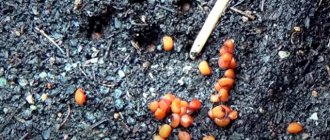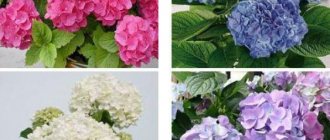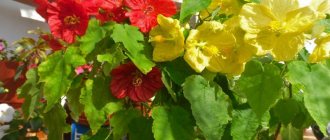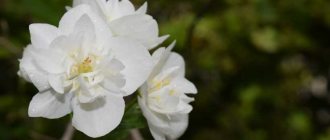Proper care of a flower is of paramount importance, since not only its appearance, but also its general condition depends on it. Caring for gardenia is even more painstaking work, since it is very demanding of the environment.
The gardenia plant is a popular houseplant that dates back to the 18th century. Botanists know about 134 species of gardenias, but the most popular among gardeners are Gardenia jasmine and Gardenia Tahitian. The gardenia flower has a delicate white corolla and can grow up to 1.5 meters in height.
Gardenia grows at home only if all the necessary conditions are present. Homemade hydrangea is much more capricious than wild hydrangea: it is very sensitive to changes in environment and prone to diseases. In our article we will talk about how to care for gardenia, how to create comfortable conditions for its growth and flowering.
Soil for gardenia in a pot
If you decide to plant gardenia at home, then you need to choose the right soil and prepare it for the process of planting the flower.
When choosing soil, you need to pay attention to the following aspects:
Soil type
Gardenia needs acidic soil, so you can mix leaf, coniferous, and turf soil in a 1:1 ratio. It is also necessary to add 1 part of sand and peat soil. In no case should you add lime to the mixture, as this can lead to the death of the flower. If you can’t make soil yourself, purchase soil for azaleas.
pH level
Before planting the plant, you need to check the pH level of the soil. It should be in the range from 4.5 to 5.5.
3.Varieties:
3.1. Jasminoid or regal gardenia - Gardenia Jasminoides
An evergreen shrub from 1.5 to 2 m high with abundantly branching, erect stems. The leaves are dark green, up to 10 cm long, thick, glossy, entire, lanceolate. The leaf blades are covered with a network of branched veins. Leaf petioles are short. The flowers are large - reaching a diameter of 8 cm, reminiscent of a rose, and emit a very intense aroma reminiscent of jasmine. Flowering occurs from May to July.
↑ Up,
3.2.Tahitian gardenia - Gardenia taitensis
Tall multi-stemmed shrub, reaching 4 meters in height. The leaves are lanceolate, entire, dark green, arranged in opposite pairs. The leaves reach 15 - 16 cm in length. Leaf veins are often highlighted in a lighter shade. The shoots are thin, flexible, abundantly branched. The flowers are light - white or cream, up to 9 cm in diameter, and have a sweetish aroma.
↑ Up,
3.3.Vietnamese gardenia - Gardenia vietnamensis
Fast-growing, evergreen, multi-stemmed shrubs with thin shoots up to 1 m high. The leaves are oblong, lanceolate, dark green, entire. The flowers are cream-colored, solitary, with narrow, long petals, and have a sweetish aroma that intensifies in the evening and night hours.
↑ Up,
3.4.Gardenia Thunberg - Gardenia thunbergia
Multi-stemmed, dense, evergreen, large-flowered shrub or small flowering tree, height from 1.5 to 4.5 m. Leaves are oblong - oval, lanceolate, glossy, dark green, collected in whorls of 3 - 4. Flowers are showy, cream, large reach a diameter of 8 cm. During the flowering period, the shrub emits a pleasant aroma, which is especially intensified at night and in the evening.
↑ Up,
How to fertilize gardenia
Fertilizer allows you to replenish a number of useful substances necessary for the growth and development of the flower. If the gardenia is still very young, use mineral or organic fertilizers (such fertilizers must be applied every two weeks). When growing an adult flower, it is best to use fertilizers that do not contain calcium. Gardenias need to be fed with this fertilizer every week. If it happens that the gardenia leaves begin to turn yellow, you can make a weak solution of iron sulfate. It will restore the plant and prevent yellowing of other leaves.
Popular questions and answers
We asked houseplant collector Elizaveta Starostina - she answered the most popular questions from summer residents.
How to choose a gardenia?
When choosing a gardenia, pay attention to the condition of the plant: good turgor of the leaves, their glossy bright color, absence of signs of diseases and pests. Ask the seller to remove the earthen ball from the container - this way you can see how developed and healthy the root system is.
What to do with gardenia after purchase?
The climate at home is completely different than in a greenhouse or flower shop, so it takes time to acclimatize. To begin with, I arrange a quarantine, wash the pot, spray the plant with an insecticide, create greenhouse conditions for it for 2 - 3 days - pour water into a pan, cover the plant with a large plastic bag and place it in a bright, but not sunny place. Then I begin to accustom it to indoor conditions, and after a couple of weeks I transplant the plant into fresh soil.
Why do gardenia leaves turn yellow?
The main reason is chlorosis caused by iron deficiency. This is the result of watering with hard water. I recommend replanting the plant in a new substrate, using only soft water for watering, and maintaining optimal soil acidity. Use complex mineral fertilizer enriched with microelements for feeding. Also, yellowing can be caused by excess water in the root area, which leads to their rotting.
Why do gardenia leaves turn black?
The reasons may vary. The lower leaves begin to turn black due to excess watering and lack of air in the soil. Adjust watering and loosen the soil. Black leaves in the crown may be the result of a fungal disease. Therefore, regularly spray your plants with biofungicides.
Why do gardenia leaves dry out?
The leaves wither and dry out with infrequent watering and low air humidity. Adjust watering so that the soil is always slightly moist; spray the plants with warm, soft water 2 times a day.
Why do gardenia buds fall off?
There are several reasons: dry air in the room, lack or excess of moisture, poor lighting or a sharp temperature change. Adjust watering, do not forget to humidify the air. If necessary, add additional light to the plant. From the moment the buds appear, do not change the place of cultivation, do not turn the other side towards the light and protect from drafts and sudden changes in temperature.
Sources
- Gardenia // Great Soviet Encyclopedia [in 30 volumes] / ch. ed. A.M. Prokhorov. – 3rd ed. – M.: Soviet Encyclopedia, 1969 - 1978
- Doronina N.V. Healing powers of indoor plants // Ridero, 2019
- State catalog of pesticides and agrochemicals approved for use on the territory of the Russian Federation as of July 6, 2022 // Ministry of Agriculture of the Russian Federation https://mcx.gov.ru/ministry/departments/departament-rastenievodstva-mekhanizatsii-khimizatsii-i -zashchity-rasteniy/industry-information/info-gosudarstvennaya-usluga-po-gosudarstvennoy-registratsii-pestitsidov-i-agrokhimikatov/
Features of care
As already mentioned, gardenia is a flower that is very sensitive to environmental changes, so it is very important to follow the following rules:
Avoid temperature changes in the room where this flower grows
Sudden changes in soil and air temperature can greatly harm gardenia, so you need to ensure that it is constant and within acceptable limits.
Create artificial lighting in winter
Gardenia comes from southern countries, so it constantly needs sunlight. In summer there is enough of it, but in winter it is necessary to compensate for its deficiency so that the gardenia does not wither and continues to bloom. This should only be done if the gardenia begins to fade. Artificial lamps can be used for lighting.
Care for your gardenia regularly
Irregular care of your gardenia can cause it to wilt. For this reason, caring for it should be regular, especially in spring and summer, when it begins to bloom with renewed vigor.
A very whimsical plant - to take it or not to take it?!
As beautiful as indoor gardenia is, it is just as capricious. Reviews are mixed. Many gardeners do not have the patience to grow a full-fledged beautiful flower.
- Home gardenia loves light, warmth, and high humidity.
- Drafts are detrimental to her.
- Special mention should be made about watering. Tap water is too hard for it. It requires watering with soft, settled water, preferably rain.
- The plant cannot be frequently rearranged or the temperature regime changed.
- Flowers that have bloomed should be picked off immediately.
- Its leaves can be coated with a polish based on natural ingredients.
Only a few gardeners manage to please the capricious gardenia. If this succeeds, the house will have a real exquisite decoration that will easily fit into any interior.
For a beginner, purchasing this beauty will most likely be a temporary purchase. At first, it will delight the whole family with lush flowering, and new leaves may appear. However, after a month, the plant will begin to shed unopened buds, and then foliage will follow. This is an alarming signal that does not bode well. It will not be possible to revive gardenia.
This disastrous result signals more than just your mistakes. We most often buy gardenia from Holland. In Europe, all flowering plants are bought precisely because of their beautiful lush flowering. Therefore, the manufacturer makes every effort to stimulate the appearance of buds as much as possible. For this purpose, a complex of fertilizers and artificial lighting are used. The result is achieved - a lot of lush green bushes appear on the shelves of flower shops, completely dotted with buds and flowers. But a one-time effect. The flowers are so exhausted that they die after flowering ends. In fact, it is an alternative to cut flower bouquets. They will last longer, but will not settle in the house for many years, such as monstera and ficus.
Possible problems
- Very slow development, lack of flowering, pale foliage. The flower lacks nutrition and light.
- Gardenia leaves turn yellow or become covered with yellow spots. There is not enough soil acidity, the soil needs to be acidified.
- The flower droops, loses its buds, and the leaves become limp. It is necessary to check the temperature; most likely, it is below normal.
- Leaves fall, sometimes remaining green. Cold irrigation water, lack of moisture.
- The gardenia is drying up. Various unfavorable factors may occur, the most common being dry air and lack of moisture.
- Reset of buds and flowers. Drafts or moving the pot from place to place, sudden changes in lighting intensity.
Preparing for transplant
At the point of sale, plants are kept in small containers. For gardenia to develop well, it requires a certain soil composition and a larger container. After purchasing, the flower should be transplanted into another container. It is better to do this in the spring. If work needs to be done earlier, you must wait at least two weeks.
Before the procedure, water the gardenia thoroughly so that the roots are not damaged when taken out of the pot. You need to choose the right container. For a small plant, a simple plastic cup will do. When the roots completely fill it, you should transplant the bush into a larger container.
Transplantation process
The gardenia is carefully removed from the container and placed in a larger pot. The soil is not completely removed from the roots. A special drainage is placed at the bottom of the container. You can use pebbles, expanded clay or other material. Then the soil is poured in and watered. The roots must be carefully examined and dried elements removed. If there are rotten parts, they are also removed. Gardenia roots need to be kept in a solution of potassium permanganate. Place the plant with soil in the pot, level it, and water it again.
In flower shops you can purchase a ready-made composition that is suitable for the flower. At home, it’s easy to make the desired mixture yourself.
If you brought a bush with white buds from the store, then the replanting process should be postponed. You should wait until the flowering process is complete.
Replanting is also performed if you need to completely change the soil or check the condition of the root system. The procedure begins after flowering, when the gardenia is in the dormant phase. It is carried out more often in autumn or early winter.
Water the gardenia with settled water at room temperature. After transplantation, the leaves of the bush may wither. This phenomenon is considered normal for gardenia. If favorable conditions are created, then after a week the flower will come to life. Replanting a tropical plant is stressful, so it is worth providing it with peace after this procedure.
Healing properties
In folk medicine, the fruits and roots of indoor gardenia are often used - a decoction of them is an antipyretic, anti-inflammatory and hemostatic agent. It is also taken for skin diseases, stomatitis, jaundice and mastitis, to treat ulcers in the mouth and lips, hepatitis, influenza, nosebleeds, nephritis and dysentery. Extracts of their fruits reduce blood pressure.
Gardenia jasmine contains substances that are choleretic. Small fruits help with fever and pulmonary diseases, while large ones are crushed and applied to burns, bruises, tumors and various types of injuries.
general description
In the wild, gardenia is an evergreen shrub that can sometimes take a tree-like form. Belongs to the Marenov family. It grows in tropical and subtropical forests of China, India, Indonesia, and is found in Japan. It is a compact bush with a smooth stem and short branches with leathery, shiny leaves of rich green color.
Flowering is long-lasting, beginning in mid-summer and ending in October. With proper planting and proper care during this period, its shoots are completely strewn with numerous flowers in varying degrees of budding. Outwardly, they are similar to roses; they are not inferior to the queen of flowers in terms of their delicate, pleasant aroma. The elegance of appearance allows gardenia to be used in interior design of a wide variety of styles.
The closest relative of this tropical flower is coffee.
Propagation by cuttings
At the beginning of spring, flower growers plant gardenias. The cutting is obtained from the top of the plant, which is cut to 10 cm. You should choose a sharp knife. Using such a tool, a smooth cut will be obtained. The leaves are carefully removed, you just need to leave two pieces at the very top. Before planting, the cuttings are immersed in a weak solution of potassium permanganate. You can use a growth stimulator for these purposes, in which the shoot is left for 5 hours. The cuttings are planted in the soil and covered with film or a jar. In a month, new shoots will appear. If the cuttings are well rooted and begin to grow actively, they are transplanted into containers for permanent cultivation.











